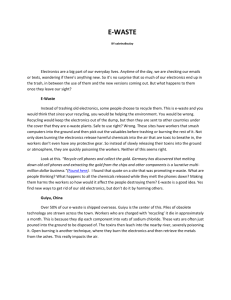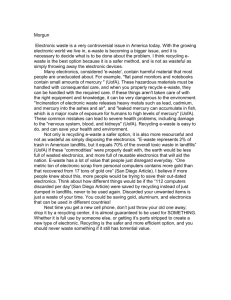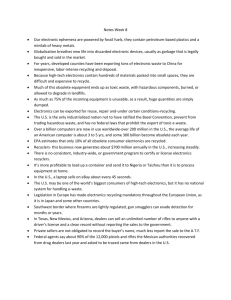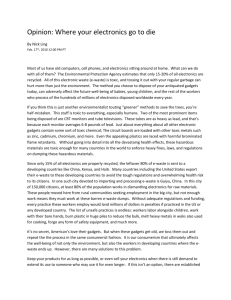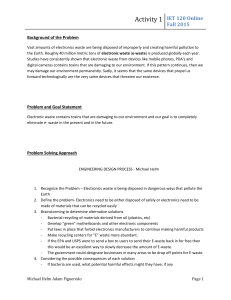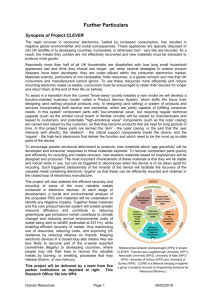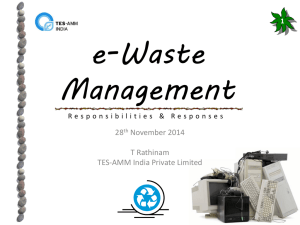Caring for our Community ~ Recycling e
advertisement
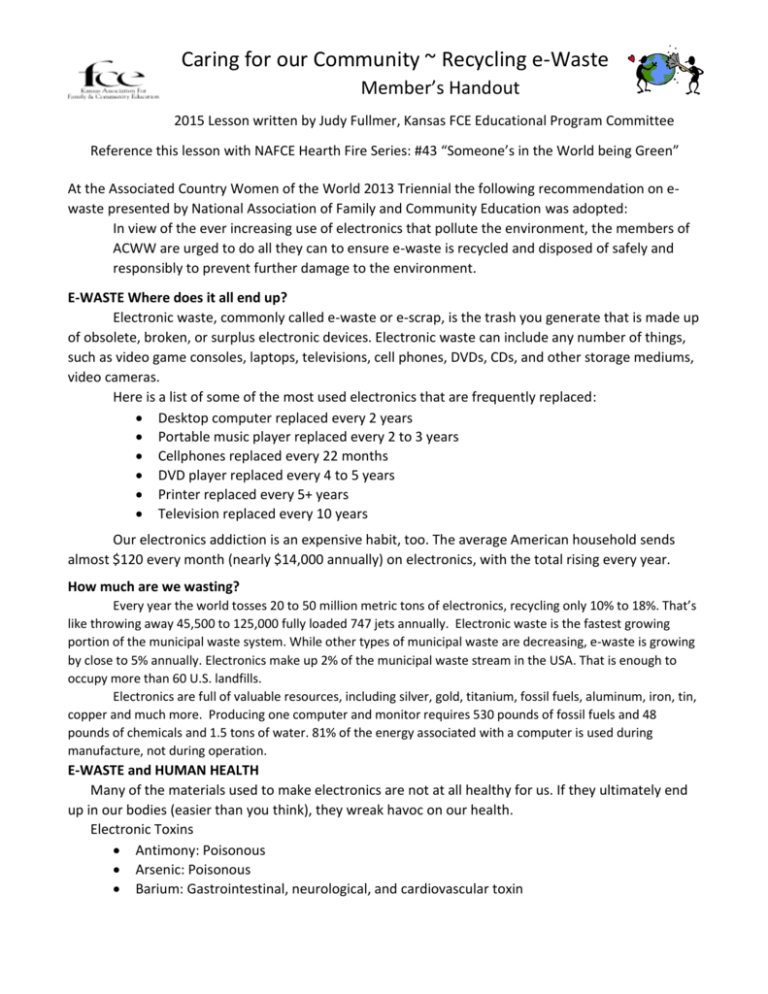
Caring for our Community ~ Recycling e-Waste Member’s Handout 2015 Lesson written by Judy Fullmer, Kansas FCE Educational Program Committee Reference this lesson with NAFCE Hearth Fire Series: #43 “Someone’s in the World being Green” At the Associated Country Women of the World 2013 Triennial the following recommendation on ewaste presented by National Association of Family and Community Education was adopted: In view of the ever increasing use of electronics that pollute the environment, the members of ACWW are urged to do all they can to ensure e-waste is recycled and disposed of safely and responsibly to prevent further damage to the environment. E-WASTE Where does it all end up? Electronic waste, commonly called e-waste or e-scrap, is the trash you generate that is made up of obsolete, broken, or surplus electronic devices. Electronic waste can include any number of things, such as video game consoles, laptops, televisions, cell phones, DVDs, CDs, and other storage mediums, video cameras. Here is a list of some of the most used electronics that are frequently replaced: Desktop computer replaced every 2 years Portable music player replaced every 2 to 3 years Cellphones replaced every 22 months DVD player replaced every 4 to 5 years Printer replaced every 5+ years Television replaced every 10 years Our electronics addiction is an expensive habit, too. The average American household sends almost $120 every month (nearly $14,000 annually) on electronics, with the total rising every year. How much are we wasting? Every year the world tosses 20 to 50 million metric tons of electronics, recycling only 10% to 18%. That’s like throwing away 45,500 to 125,000 fully loaded 747 jets annually. Electronic waste is the fastest growing portion of the municipal waste system. While other types of municipal waste are decreasing, e-waste is growing by close to 5% annually. Electronics make up 2% of the municipal waste stream in the USA. That is enough to occupy more than 60 U.S. landfills. Electronics are full of valuable resources, including silver, gold, titanium, fossil fuels, aluminum, iron, tin, copper and much more. Producing one computer and monitor requires 530 pounds of fossil fuels and 48 pounds of chemicals and 1.5 tons of water. 81% of the energy associated with a computer is used during manufacture, not during operation. E-WASTE and HUMAN HEALTH Many of the materials used to make electronics are not at all healthy for us. If they ultimately end up in our bodies (easier than you think), they wreak havoc on our health. Electronic Toxins Antimony: Poisonous Arsenic: Poisonous Barium: Gastrointestinal, neurological, and cardiovascular toxin Beryllium: Carcinogenic, Acute Beryllium Disease Cadmium: Carcinogenic, organ toxin Chromium: organ toxin, carcinogenic Dioxins: Carcinogenic Lead: Central and peripheral nervous system toxin Mercury: Central nervous system and endocrine system toxin Nickel: Carcinogenic, respiratory toxin Polychlorinated Biphenyls (PCBs): blood, skin, and organ toxin Polyvinyl chloride (PVC): Organ toxin, endocrine disruptor Health impacts of Electronic Toxins are: nose bleeds; seizures; retardation; impairment of child development; sinus perforations; mouth, teeth, and gum damage; thyroid damage; high blood pressure; irregular heartbeat; lung damage; asthma; bronchitis; cancer, kidney, liver, and digestive system damage; fetus neurological damage; ulcers; skin cancer; paralysis; and/or death. Where E-Waste ends up Those people manufacturing and deconstructing e-waste are the hardest hit with health problems. Even when you send your e-waste to a recycling facility, it may not end up where you think. Much of the electronic waste created in the U.S. is exported to countries like Ghana, Nigeria, Pakistan, India and China. There it is deconstructed by men, women and even children, who are rarely protected from the toxins. When it isn’t recycled, all of those toxins end up in the environment, at home and abroad. In all, electronics contribute to many environmental hazards: Climate emissions released during manufacture and operation Manufacturing wastewater dumped in rivers and streams Incineration and disposal of electronics Toxins released during mining of metals and minerals. Ultimately, water is poisoned, air turns toxic, soil becomes dead, and as a result wildlife, aquatic life, and plant life all suffer. As a consumer you can help. Buy durable electronics that will last longer Care for electronics to lengthen their useful life. Donate old electronics to charities Recycle broken or obsolete electronics responsibly through e-Stewards approved by the Basel Action Network. Present this lesson to your local FCE and other organizations in your community. Demonstrate how to make something useful from e-waste. Set up a collection point for e-waste and see that it is delivered to the recycler. Speak with groups in your community about the importance of recycling e-waste. Attend meetings of the city council or state legislature, if laws need to be written or changed pressure officials to pass e-waste recycling bills. Support pending legislation and keep e-waste out of landfills and incinerators. To find an electronic recycler near you in Kansas check the KansasRecycles site: http://www.kansasrecycles.org/find-a-recycling-program
